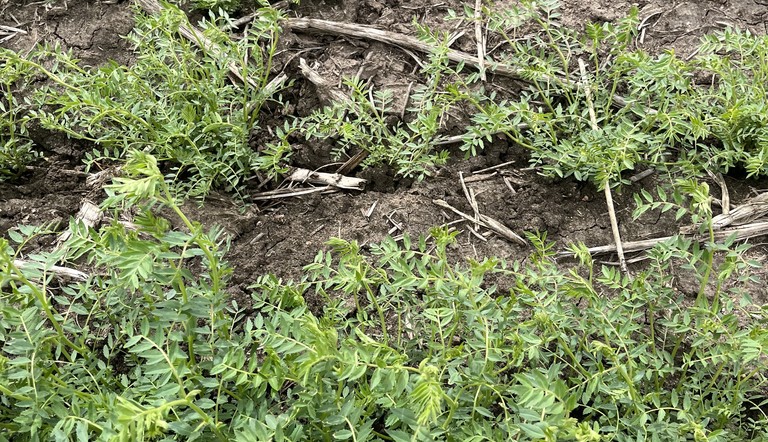
Flexible, cost-effective, improved broadleaf weed control on way for northern growers

GROWERS in Northern New South Wales and Queensland tackling problem broadleaf and woody weeds now have new-found flexibility with one of the most robust herbicides against the difficult weeds.
Together with tank-mix partners, its residual control also offers growers the vital benefit of post-harvest suppression of key weeds, sowthistle and fleabane, as well as climbing buckwheat, helping to limit these weed populations leading into fallow programs or following crops.
Aminopyralid herbicide has previously been available in co-formulations with other herbicides, however ADAMA Australia has now released a cost-effective, solo aminopyralid product for growers, Grindstone®, providing greater re-cropping flexibility.
Available from the company as a unique soluble liquid formulation, Grindstone enhances partner herbicide efficacy of broadleaf and woody weeds, also including African boxthorn, blackberry, lantana, sweet briar and wattle, in winter cereals, fallow, grass pasture and non-crop situations.
Jim O’Connor, Market Development Manager with ADAMA Australia for Queensland, said aminopyralid had been available with metsulfuron and commonly mixed with MCPA and picloram herbicides, whereas Grindstone offered growers the flexibility to “dial their own rate’’ of aminopyralid and then add herbicides like metsulfuron, fluroxypyr and picloram according to their situation.
“They will have the ability to better customise their herbicide tank mixes. It will be more cost-effective, and the soluble liquid is user-friendly and easier to handle than existing granular products,’’ Jim said.
“In addition to boosting the efficacy of post-emergent weed control in cereals, tank mixes like Grindstone and Picoflex® will also provide a post-harvest residual effect on weeds like fleabane and sowthistle. This helps to ensure growers don’t come out of harvest with a mess. They can keep weed populations lower leading into post-harvest fallow programs or through to the next winter crop.’’
The ability to select the rate of aminopyralid and other herbicides in tank mixes also allows greater re-cropping flexibility.
Grindstone is compatible with a broad range of grass and broadleaf herbicides and doesn’t compromise efficacy of commonly used selective grass herbicides in cereal crops.
Jim said for Queensland grazing areas, particularly in northern parts, tank mixes with Fightback®, containing picloram and triclopyr, would be effective against woody weeds.
Trials with Grindstone have demonstrated the enhanced in-crop weed control and cleanliness post-harvest for growers.
“In trials against a matrix of broadleaf crops including chickpeas, faba beans and lentils, Grindstone worked really well, especially in combination with tank mix partners,’’ Jim said.
“It will be excellent for growers on some of the tough weeds like sowthistle and climbing buckwheat.’’
For Northern New South Wales, local Market Development Manager with ADAMA Australia, Harry Pickering, said Grindstone would offer the region’s growers alternative, effective pyridine chemistry for post-emergent weed control, and would be particularly timely this season considering the short supply of other, more expensive options.
Harry agreed the solo aminopyralid would provide important flexibility for tank-mix and application rate decisions, mainly for targeting fleabane, sowthistle, climbing buckwheat and volunteer pulses in the region.
“Early post-emergent applications will be particularly beneficial against fleabane and the good residual will also help control later germinations in-crop,’’ he said.
NSW Central West grower Maurie Street coordinated a demonstration trial last season on his property investigating residual control of fleabane and other broadleaf weeds in barley following post-emergent application of Grindstone in a tank mix.
Maurie and his family grow wheat, barley and canola over several blocks about 30 kilometres east of Dubbo, while the former agronomist also is Chief Executive Officer of Grain Orana Alliance, an independent research organisation that conducts locally-identified, field-based research and extension trials in the Central West and Orana regions.
Typically, Maurie applies a tank mix of Lontrel®, Ally® and MCPA post-emergent to control fleabane and other weeds, and last year in a barley paddock he conducted a skip-row trial where Grindstone replaced Lontrel in the mix. It was on some newly acquired land that had been in pasture and featured a range of broadleaf weeds.
“We looked at the residual control with the Grindstone mix, particularly of fleabane. It often germinates in crops after post-emergent sprays and then rests under the crop and takes-off after harvest. It’s tolerant to glyphosate and it’s hard to kill,’’ Maurie said.
He said the Grindstone posed no problems with the mix or with crop phytotoxicity and the in-crop weed control was comparable with the Lontrel mix. However, after harvest it did appear there was less fleabane where the Grindstone mix was applied and this was confirmed when sitting on the spray rig over summer
Maurie said the flexibility of the solo aminopyralid with Grindstone also would appeal to many growers, providing an ability to easily “mix and match’’ products and dial different rates of application according to their individual situations and even between paddocks.
Products in the Article

Grindstone®

Fightback®
